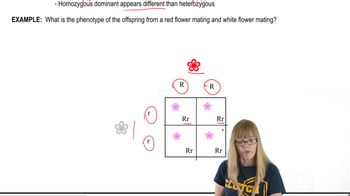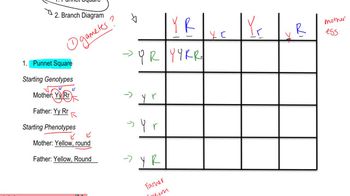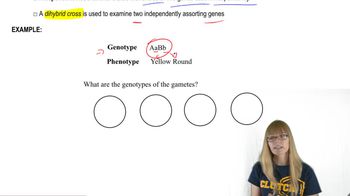Table of contents
- 1. Introduction to Genetics51m
- 2. Mendel's Laws of Inheritance3h 37m
- 3. Extensions to Mendelian Inheritance2h 41m
- 4. Genetic Mapping and Linkage2h 28m
- 5. Genetics of Bacteria and Viruses1h 21m
- 6. Chromosomal Variation1h 48m
- 7. DNA and Chromosome Structure56m
- 8. DNA Replication1h 10m
- 9. Mitosis and Meiosis1h 34m
- 10. Transcription1h 0m
- 11. Translation58m
- 12. Gene Regulation in Prokaryotes1h 19m
- 13. Gene Regulation in Eukaryotes44m
- 14. Genetic Control of Development44m
- 15. Genomes and Genomics1h 50m
- 16. Transposable Elements47m
- 17. Mutation, Repair, and Recombination1h 6m
- 18. Molecular Genetic Tools19m
- 19. Cancer Genetics29m
- 20. Quantitative Genetics1h 26m
- 21. Population Genetics50m
- 22. Evolutionary Genetics29m
3. Extensions to Mendelian Inheritance
Understanding Independent Assortment
Problem 27b
Textbook Question
Textbook QuestionThe wild-type (normal) fruit fly, Drosophila melanogaster, has straight wings and long bristles. Mutant strains have been isolated that have either curled wings or short bristles. The genes representing these two mutant traits are located on separate chromosomes. Carefully examine the data from the following five crosses. Identify each mutation as either dominant or recessive. In each case, indicate which crosses support your answer.
 Verified Solution
Verified SolutionThis video solution was recommended by our tutors as helpful for the problem above
Video duration:
2mPlay a video:
Was this helpful?
Key Concepts
Here are the essential concepts you must grasp in order to answer the question correctly.
Dominant and Recessive Traits
In genetics, traits can be classified as dominant or recessive based on their expression in the phenotype. A dominant trait is one that is expressed in the presence of at least one dominant allele, while a recessive trait requires two copies of the recessive allele to be expressed. Understanding these concepts is crucial for analyzing genetic crosses and predicting offspring traits.
Recommended video:
Guided course

Variations on Dominance
Dihybrid Crosses
A dihybrid cross involves two traits, each represented by two alleles, allowing the study of inheritance patterns for two different characteristics simultaneously. In this scenario, the crosses between wild-type and mutant fruit flies will help determine the inheritance of wing shape and bristle length. Analyzing the offspring ratios from these crosses can reveal whether the traits are linked or independently assorted.
Recommended video:
Guided course

Punnet Square
Chromosomal Location of Genes
The location of genes on separate chromosomes indicates that they assort independently during meiosis, following Mendel's law of independent assortment. This principle is essential for predicting the inheritance patterns of traits in the offspring. In the case of Drosophila, knowing that the genes for curled wings and short bristles are on different chromosomes helps in determining the dominance relationships based on the observed phenotypes in the crosses.
Recommended video:
Guided course

Chromosome Structure

 4:58m
4:58mWatch next
Master Gamete Genetics and Independent Assortment with a bite sized video explanation from Kylia Goodner
Start learningRelated Videos
Related Practice


